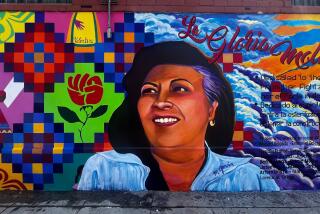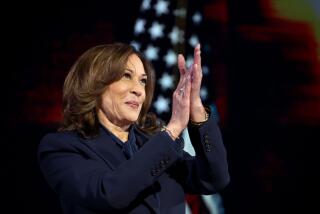Thirty years ago tonight: Geraldine Ferraro makes history
Thirty years ago tonight, all she had to say were five words and, just like that, thousands of delegates to the Democratic Party’s 1984 convention nearly blew off the roof of San Francisco’s Moscone Center.
“My name is Geraldine Ferraro,” the newly minted vice presidential nominee declared, making history.
In front of her were grandmothers, mothers, single women, young girls, babies. The men with convention passes had wisely handed them off, to the point where spotting a male delegate was rare. In the sea of women, tears fell, chants flew, feet stomped, the building rocked as if the San Andreas was joining in as the first woman ever to become a presidential or vice presidential nominee basked in what would be the high point of her campaign.
The celebrating masses paused just enough for the New York congresswoman to get out her next sentence: “I stand before you to proclaim tonight — America is a land where dreams can come true for all of us.”
Thirty years on, real emotion seems like the rarest of commodities in American politics. Is a politician collecting signatures to push change or create a tappable list of potential donors? Is an activist group begging for money to help its cause or pad its bank account? Is an audience reacting for the television cameras or from the gut? Is outrage or passion real or fake, heartfelt or a manipulation?
Sometimes, like on that night 30 years ago, there’s no question.
Many of the women in the hall had worked for years, decades even, in politics, never assuming that anyone who shared their gender would be onstage. Candidate or staffer, they were agog as they watched it happen.
As Myra MacPherson wrote in the Washington Post:
“There is probably not a woman who doesn’t have a sex discrimination story in her past, especially if she is over 40. That is part of what the emotion is about here. And when they choke up, there is a lingering sense of having to explain the reaction, to almost apologize for the tears. There had been so many years of training, so many years of learning how to ‘take it like a man,’ of worrying about sounding ‘shrill or strident.’ Too many years of hiding feelings under the dress-for-success flannel suit, of seeing younger, less qualified men get the promotion, of juggling car pools and corporate board meetings, of being tough enough to stick it out on an assembly line, working nights to be home in the day with the children.”
Ferraro would go on to be one of the highlights of a losing campaign, a spark to the buttoned-up Democratic presidential nominee, Walter Mondale. Sassy and blunt, she brought the campaign to her grocery store in Queens, she sat for a marathon news conference probing her family’s finances, she crossed the country to rally opposition to the incumbent president, Ronald Reagan. Thousands showed up to herald her, no small feat for a campaign that would ultimately win only a single state.
The reaction would be much the same two dozen years later when, in a similar Hail Mary move, Republican John McCain picked Alaska Gov. Sarah Palin as his vice presidential nominee, the first woman from her party to be so honored. Crowds gathered, drawn again by the undercard, but the campaign itself ultimately was doomed. Vice presidential candidates, it was proved again, rarely turn the course of history.
By Palin’s time, at least, voters were far more used to women on the political stage, and not just as the supportive wife.
In 1983, the year before Ferraro accepted the nomination, the stats were bleak: 4% of House and Senate members were female; 11% of statewide elected officials in the country were female; 13% of state legislators were female, according to Rutgers’ Center for American Women and Politics.
Thirty years later, there’s not parity but the numbers are closer: 18.5% of the House and Senate is female; 23% of statewide officials are female; 24% of state legislators are female.
Women have run for president from both parties since Ferraro’s turn. The Democratic front-runner for 2016 — though not yet an announced candidate — is Hillary Clinton, who Ferraro fiercely supported in 2008.
Ferraro died three years ago, and a short time later, on NBC’s “Meet the Press,” Clinton lauded her role as a “path breaker.”
“She went before many women to a political height that is very difficult still, and she navigated it with great grace and grit,” Clinton said.
Donna Zaccaro, a filmmaker and Ferraro’s daughter, has crafted a documentary called “Geraldine Ferraro: Paving the Way” that seeks to tell her mother’s story, particularly to those too young to remember.
“We might not understand what her impact was or the impact of a candidacy that, frankly, didn’t win,” Zaccaro told PBS’s Judy Woodruff.
“But I think younger people today don’t have any idea what it was like before.... People who are over 35 do remember, but again they might not remember much, other than the fact that she was nominated.
“They might not remember what it was like before there was a woman who had run and shown that you could be a credible candidate.”
For those who were in the hall that night 30 years ago, it remains unforgettable.
For political news and analysis, follow me on Twitter: @cathleendecker
More to Read
Sign up for Essential California
The most important California stories and recommendations in your inbox every morning.
You may occasionally receive promotional content from the Los Angeles Times.










